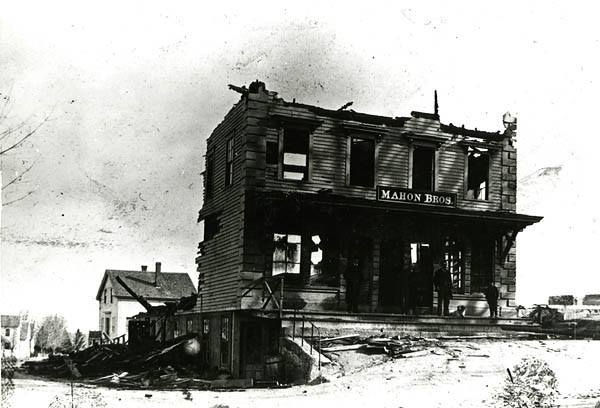Three historic fires devastated the town
- Cathy Buday
- Jul 20, 2016
- 4 min read

In the early morning of April 4, 1882, a case of gunpowder behind P.W. Smith’s clothing store ignited.
Soon after, a huge explosion shook the entire business district of Hopkinton and jolted terrified residents out of bed. Within minutes, fire destroyed the clothing store, Town Hall, a boot factory that employed 600, and many other Hopkinton buildings. The 1882 blaze remains as Hopkinton’s worst fire, with damage totaling nearly $10 million in today’s dollars.
That fire – and two others, in 1876 and 1900 – would have a lasting impact on Hopkinton’s architecture, economic wellbeing, quality of life and population. Many say the fires dealt the knockout punch to the shoe industry, which had brought prosperity and a population boom to Hopkinton in the mid 1800s. According to the Massachusetts Historical Commission, by 1880 Hopkinton was beginning to lose its luster, as other towns lured away shoe and boot factories. The fires did not help.
“Manufacture of boots and shoes peaked in 1880 with nine large plants, three being the property of a single organization,” the MHC notes in a 1980 historical survey of communities. “By this time, however, growth of nearby manufacturing centers, Milford and South Framingham, coupled with a series of disastrous fires in 1876, 1882, and 1900 caused a rapid decline.”
While the 1882 fire was Hopkinton’s worst, another fire just six years earlier had already hobbled downtown. The 1876 fire started in the storehouse basement of the Claflin, Coburn & Co. boot factory on Main Street.
Nearby supplies of coal and tar quickly fed the flames. Within 10 minutes the fire engulfed 1,200 cases of boots and spread to the storehouse roof, the main factory building, Winslow Corbett’s stable and a small barn.
Town Hall, just 14 feet from the burning factory was saved thanks to the efforts of firefighters from Hopkinton’s three fire stations and Ashland. But the boot factory was completely destroyed; damage was close to $200,000 -- $4.4 million in today’s dollars. Its 250 workers suddenly were without jobs.
Tragedy would befall Claflin & Coburn again in the historic 1882 fire. The company built the Bridges & Co. boot factory to replace the factory that had been destroyed six years earlier, but that replacement burned to the ground in 1882. While it escaped the 1876 fire unscathed, Town Hall was doomed this time because the P.W. Smith clothing store, where the fire started, was located in the same building. The Post Office, Highland House Hotel, Walcott mansion, and other structures also went up in flames. So did many smaller businesses – a milliner, dentist, billiard hall, barber and dry goods store. Even the Congregational Church was destroyed; its spire dramatically crashed to the ground and only a piano was saved.
Late Hopkinton historian Gordon Hopper noted that the 1882 fire would have been far worse without firefighters’ valiant efforts. At the Mahon Brothers building, wrote Hopper in a 1974 article, “There were 15 barrels of kerosene stored in the basement…and the firemen put up a tremendous effort to check the fire at this point.” Sadly, Hopper noted, “once again, the largest losers were the working men of Hopkinton. Bridges & Co. factory had employed 450 people in the shop and about 150 more on the outside. It was the mainstay of Hopkinton.” Close to 6,000 cases of boots were destroyed as well.
News of the 1882 fire spread around the country. The New York Times called it “A disastrous conflagration in Hopkinton, Mass.,” and noted that “the explosion was quite loud and was heard by many in the vicinity.”
Vulcan was not finished with Hopkinton yet. In 1900 a third fire struck, destroying both Town Hall and the Mahon Brothers business once again. This fire started in the Bridges block and also destroyed the Savings Bank building. Damage from that fire was $2.8 million in today’s dollars.
After three infernos, many Hopkinton businesses never recovered. Shoe manufacturers went elsewhere. “The fire of 1882 destroyed the largest plant of Bridges & Co. and persuaded another to move to South Framingham,” notes the MHC in its 1980 historical report. “By 1885 only four plants remained; by 1895 there was only one.”
Hopkinton’s population declined to less than 2,500 by 1915, about half what it was in 1880. The town, once bustling, grew sleepier. Its population would not reach 1880’s levels until during the 1950s.
While many businesses and people left town, Hopkinton rebuilt – this time with materials that could withstand the flames. A brick Town Hall, built in 1902 where the destroyed Highland House hotel once stood, survives today.
And according to Hopkinton Fire Chief Ken Clark, today’s construction materials, fire codes and inspections have minimized the chance for widespread destruction like the town saw in 1876, 1882 and 1900.
“Even some of our older buildings with heavy timber construction now have sprinkler systems and fire alarms,” Clark points out. “Newer buildings are built to strict codes that include sprinklers and standpipe systems, which let firefighters tap into the water supply from inside the building. And our inspectors work tirelessly to ensure that our schools, commercial buildings and homes are safe.”
Still, firefighters, builders and homeowners should never stop learning. Clark said tragedies such as the Worcester Cold Storage and Warehouse fire in 1999, and Rhode Island’s deadly Station Nightclub fire in 2003, are sobering reminders that fire safety can never be taken for granted.


















Comments